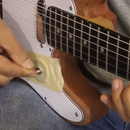Introduction: Wooden Bunk Bed With 2x6 Lumber
While you can buy a bunk bed in the $200 range, chances are it won't be very sturdy. This bunk bed design is solid enough to hold me, a ~245 pound adult (as seen around 7:53 in the project video) and should be great for kids. I also added LED lighting to the underside of both levels, which looks quite nice.
Step 1: Lumber Cuts and Materials
For this bed, you'll need the following lumber sections:
- -2x6 (4) 75.5 inches [horizontal bed support]
- -2x6 (8) 44 inches [ladder sections]**
- -2x6 (2) 67 inches [long upright]
- -2x6 (2) 57 inches [shorter upright]
- -2x4 (1) 78.5 inches [top bar]
- -2x3 and 2x2: cut to suit, bed support
As (2) 44 inch sections can be cut out of a piece of 8 foot 2x6 lumber, you'll need to purchase a total of (12) 2x6s to cut.
Note that if you want the bed to be wider, the ladder section can be expanded. The bed fits a 38" wide mattress, but some are 39", slats also may be tight or need to be modified. If I was building again, I might make this **44 1/4 inches.
Hardware and other materials:
- (26) 3/8 - 16 Anchors [Amazon] or this multi-pack [Amazon] similar price, adds other sizes
- (26) 3/8 - 16 Bolts [eBay], 2 1/2 inches long
- Stain/Urethane/Paint
- (optional) LED lighting [Amazon]
Wood cost will be around $150, total cost around $300 excluding slats/mattresses.
Step 2: Cut Dovetails for Ladder, Drill Holes
Drill Holes are shown in drawing and in video for 5/16 - 18 BHCS and sink anchors.
Cut dovetails as shown in video or via other means, then attach ladder sections with wood screws and glue.
Step 3: Stain and Assemble
I used two coats of cherry stain here, along with three coats of semi-gloss urethane.
Plugs were used to cover wood screws, which is optional, but gives it a nice look. I kept these unstained to contrast with the main wood section. Mine were laser cut, but should be available for purchase as well.
Step 4: Optional LED Lighting
Optionally, you can add LED lighting to the bottom, which makes for a nice effect. As outlined in the video, some of the supporting wood didn't reach all the way to the bottom, allowing lights to be recessed. LEDs were connected using CAT 6 Ethernet cable, and run through holes drilled in the upright supports.
Step 5: Enjoy!
While somewhat of an involved build, I found it to be quite fun, and was extremely pleased with the end result. If you decide to build one yourself, I'd love to hear how it went (Twitter @JeremySCook). Also, I made a few minor mistakes along the way, which are documented in the video and may save you some headache!
Note that Amazon links are affiliate, meaning I get a small percentage of sales.













